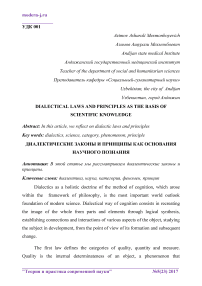Dialectical laws and principles as the basis of scientific knowledge
Автор: Azimov A.M.
Журнал: Теория и практика современной науки @modern-j
Рубрика: Основной раздел
Статья в выпуске: 5 (23), 2017 года.
Бесплатный доступ
In this article, we reflect on dialectic laws and principles
Dialectics, science, category, phenomenon, principle
Короткий адрес: https://sciup.org/140271619
IDR: 140271619
Текст научной статьи Dialectical laws and principles as the basis of scientific knowledge
Dialectics as a holistic doctrine of the method of cognition, which arose within the framework of philosophy, is the most important world outlook foundation of modern science. Dialectical way of cognition consists in recreating the image of the whole from parts and elements through logical synthesis, establishing connections and interactions of various aspects of the object, studying the subject in development, from the point of view of its formation and subsequent change.
The first law defines the categories of quality, quantity and measure. Quality is the internal determinateness of an object, a phenomenon that characterizes an object or phenomenon as a whole. Quality is the first direct certainty of being. The quantity is definiteness, «indifferent to being» - the external definiteness of a thing. Quality and quantity can not exist independently of each other, since any thing or phenomenon is determined by both qualitative characteristics and quantitative indicators. «A demonstration» of qualitative and quantitative certainty is a measure, that is, the ratio of indicators, a kind of balance. The violation of the measure changes the quality and transforms one thing into another, or one phenomenon into another. There is a break in gradualness, or a qualitative leap is a general form of transition from one qualitative state to another.
A classic example of the transition from quantitative changes to qualitative changes are the transformation of ice-water-steam. As the ice warms up, a quantitative change first takes place - a rise in temperature. At 0 ° C, despite the continuation of heating, the temperature ceases to grow, the ice turns into water. This is already a change in quality. Further heating of the water again provokes a quantitative (temperature increase), and then a qualitative (transformation into the right at ° C) changes.
The second law of dialectics reveals its inner source in development. The basis of all development, from the point of view of Engels, is the struggle of the opposite sides. In disclosing the operation of this law, he stressed the existence of a connection and interaction between opposites, proving that they are moving, interconnected and interacting trends, and this relationship is expressed in the fact that each of them has its own opposite.
Hegel called this kind of mutual relation of contradictions contradictions. «Contradiction is the root of all movement and vitality, only because it has in itself a contradiction, it moves, has momentum and activity.» The resolution of any contradictions is a leap, a qualitative change of the given object, turns it into a qualitatively different object, denying the old one.
The unity and struggle of opposites in physical processes can be illustrated by the example of the principle of corpuscular-wave dualism, according to which any object can exhibit both wave and corpuscular properties. In biological evolution, it is through the struggle of heredity and variability that the formation of new forms of life takes place.
The third law of dialectics reflects the overall result and direction of the development process. Negation means the destruction of the old quality by the new, the transition from one qualitative state to another. The development process is progressive. Perpetuity and repeatability give a cyclic spiral shape and each stage of the development process is richer in content, as it includes all the best that has been accumulated in the previous stage. Logical negation of the negation: «This is true»; «This is not true»; «This is not incorrect.» The last proposition is negative, but in another respect it is equivalent to the affirmative.
Used sources:
-
1. Gornshtein TN Dialectical method / Chapter Four // Philosophy of Nikolai Hartman. (Critical analysis of the main problems of ontology). - Leningrad: "Science", 1969.
-
2. Evarist Sanchez-Palencia. Dialectical walk in science. 2012
-
3. Culturology. XX century. Anthology. - M .: Lawyer, 1995.
-
4. Hartman N. The problem of spiritual being. Studies to substantiate the philosophy of history and the sciences of the spirit. Philosophical and historical introduction / / Culturology. XX century. Anthology. - M: Jurist, 1995. - P. 608648
-
5. Dynnik MA Dialectics of Heraclitus of Ephesus. - M., 1929.
-
6. Zelkina OS System-structural analysis of the main categories of dialectics. -Saratov, 1970.
Список литературы Dialectical laws and principles as the basis of scientific knowledge
- Gornshtein TN Dialectical method / Chapter Four // Philosophy of Nikolai Hartman. (Critical analysis of the main problems of ontology). - Leningrad: "Science", 1969.
- Evarist Sanchez-Palencia. Dialectical walk in science. 2012
- Culturology. XX century. Anthology. - M.: Lawyer, 1995.
- Hartman N. The problem of spiritual being. Studies to substantiate the philosophy of history and the sciences of the spirit. Philosophical and historical introduction // Culturology. XX century. Anthology. - M: Jurist, 1995. - P. 608-648
- Dynnik MA Dialectics of Heraclitus of Ephesus. - M., 1929.
- Zelkina OS System-structural analysis of the main categories of dialectics. - Saratov, 1970.


